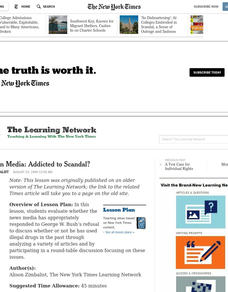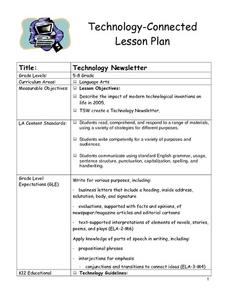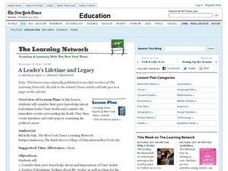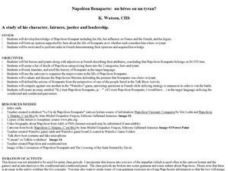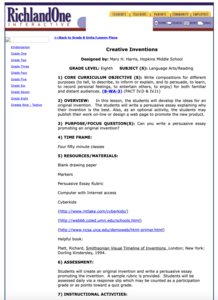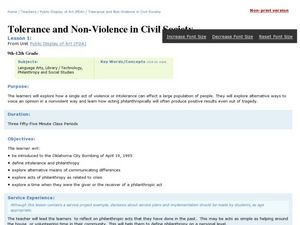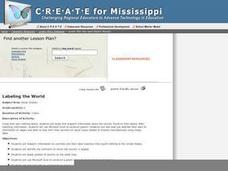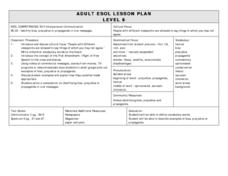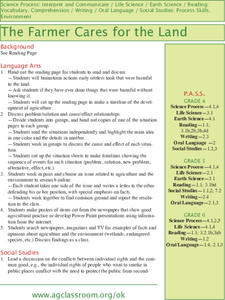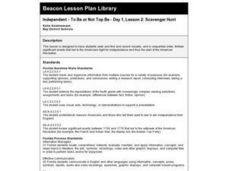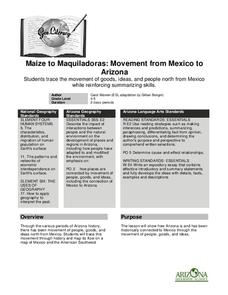Curated OER
A River, Dead or Alive: Native Americans and European Colonists' Treatment of a River
Students write an expository paragraph about the uses of the Nashua River for the Native Americans and the European Colonists. In this river uses lesson plan, students determine the causes and effects of both parties using the river.
Curated OER
EARLY CIVILIZATIONS
Students compare and contrast the monuments of four ancient cultures and draw conclusions about the origins, construction, and purposes of these structures.
Curated OER
American Media: Addicted to Scandal?
Students examine media coverage of George W. Bush's refusal to answer questions regarding past illegal drug usage in the 1999 campaign. They consider the role of rumor, scandal, audience and relevance in political media coverage.
Curated OER
Technology Newsletter
Students discuss impact and value of modern technological inventions on society, contemplate world without technology, skim magazines and newspapers for advertisements highlighting modern technologies, and work with partner to create...
New York State Education Department
TASC Transition Curriculum: Workshop 11
You'll C-E-R a difference in classroom achievement after using a helpful lesson. Designed for economics, civics, government, and US history classes, participants practice using the CER model to craft arguments about primary and secondary...
Curated OER
A Leader's Lifetime and Legacy
In this lesson plan, students consider their prior knowledge about Palestinian leader Yasir Arafat and consider the immediate events surrounding his death. They then create timelines and write papers examining his political career.
Channel Islands Film
Arlington Springs Man: Lesson Plan 1
Learning to craft quality questions is a skill that can be taught. Class members use the Question Formulation Technique to learn how to create and refine both closed-ended and open-ended questions. They then view West of the West's...
Curated OER
Discrimination and Media: Focus on Mental Health
Students explore discrimination by the media. In this media awareness instructional activity, students examine stigmas concerning mental illnesses as they are portrayed in the media.
Curated OER
Columbus: Hero or Villain?
Students explore Christopher Columbus's motives. In this character education lesson plan, students research Internet and print sources regarding the life and actions of Christopher Columbus in order to write essays that his actions as...
Curated OER
Writing Author's Purpose
Write in all three authorial purposes (persuasive, informational, entertaining) with this lesson. Young writers consider a time when a friend of theirs helped them out and gave them advice on something. They write a short paragraph (no...
Bantam Books
The Tempest: Chalk Talk
Discussion doesn't always need to be spoken. Before you begin The Tempest by William Shakespeare, have kids connect their ideas and experiences to central questions of the play with a silent discussion activity. Once they have...
Curated OER
Napoléon Bonaparte: un héros ou un tyran?
Was Napoléon Bonaparte a hero or a tyrant? Discuss examples of each, and list their common attributes. Then, to form a solid argument and take a stance, intermediate and advanced Francophones conduct Internet research. After a few days...
Curated OER
Creative Inventions
Ninth graders develop ideas for an invention and write a persuasive essay explaining why their invention is best. In this invention essay lesson, 9th graders review persuasive essay writing. Students create a graphic web for an original...
Curated OER
Tolerance and Non-Violence in Civil Society
Students explore the concept of philanthropy. In this Oklahoma City bombing lesson, students submit public responses to the event in order to consider how the tragedy prompted a positive reaction. Extension activities are included.
Curated OER
Labeling the World
Sixth graders conduct research on the countries found on the labels on their clothing. They locate the countries on a map, research the labor practices on countries that export clothing to the U.S., and create a graph using the information.
Curated OER
Strategic Skill: Evaluating Information Quality Using Electronic Sources
Fourth graders review and complete evaluating information quality. In groups, they research the diversity of the numerous Native American tribes in Montana. They complete a worksheet on evaluating sources on the Internet and share...
Curated OER
Independent - To Be or Not Top Be - Day 2, Lesson 3: In the Course of Human Events
Fifth graders practice scanning skills to answer questions on the French and Indian War.
Curated OER
Agree To Disagree
Young scholars discover their own talents and preferences and determine how they apply to the world of work with a group activity. They express their choice and discuss their positions.
Curated OER
The Farmer Cares for the Land
Students identify cause and effect relationships in issues relating to agriculture and the environment.
Curated OER
Independent - To Be or Not Top Be - Day 1, Lesson 2: Scavenger Hunt
Fifth graders research the thirteen significant events that lead to the start of the American Revolution.
Curated OER
Using "Why Mosquitoes Buzz in People's Ears" to Teach Cause and Effect
Students discuss cause and effect relationships and the chain reaction involved before listening to the story "Why Mosquitoes Buzz in People's Ears". Students create flow charts to show the chain reactions of causes and effects in the...
Curated OER
Should the United States Have a Central Bank?
Students assess the validity of a national bank. They study the importance of McCullough v. Maryland. They review the arguments of Hamilton and Jefferson. They analyze the Tenth Amendment and the debate over state v. federal power. They ...
Curated OER
Maize to Maquiladoras: Movement from Mexico to Arizona
Students label maps of Arizona and Mexico of the products that moved from one place to another. In this Arizona and Mexico lesson plan, students also summarize the effects of the movement on life in Arizona.
Curated OER
Technology-commected Folklife Lesson Plan: Fables
Learners discuss ways the stories were alike and different. The teacher demonstrate how to draw a Venn diagram using Microsoft Word. They label the two circles and enter the likenesses and differences on the diagram.
Other popular searches
- Fact vs. Opinion Reading
- Fact vs Opinion Reading
- Fact or Opinion Reading
- Fact and Opinion Reading
- Facts and Opinions for Reading
- Fact and Opinion in Reading




